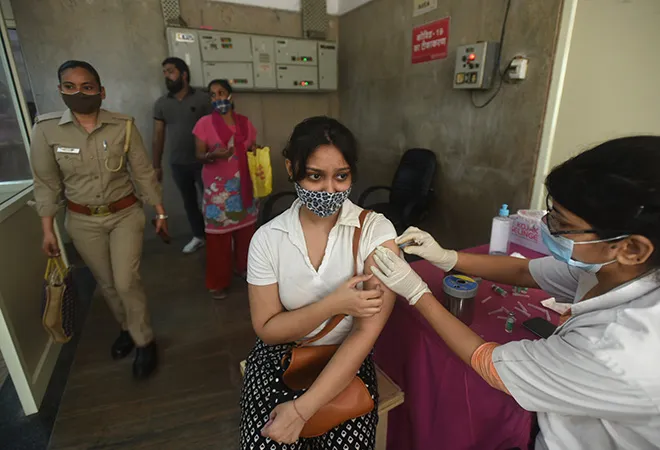
Over the course of the pandemic, there have been studies that have proven that the severity of COVID-19 varies across social, economic, and biological groups. Similarly, the effects of the vaccines could also differ across the same dimensions. We have already witnessed that the after-effects are higher amongst the youth in comparison to the elderly population as they seem to have a more robust immune system. Likewise, though it lacks more concrete research, on balance, it has been noted that women seem to be having more side effects in comparison to men; both genders have common side effects like fever, body ache, nausea, etc.; however, women are also experiencing menstrual and hormonal changes.
Another noteworthy fact is that most of the adverse effects recorded have predominantly been experienced by women. For instance, in the recent Pfizer vaccine side effects, we saw severe allergic reactions after the first dose. Out of the 21 cases reported, 19 of them were women. A similar fate was met by women who were administered the Moderna vaccine. The more life-threatening clotting issues that led to a drop in platelet levels within two weeks of inoculation was observed in the AstraZeneca vaccine (Covishield), in which out of 24, 18 of them had succumbed to it—all were women. Though in the case of Moderna and Pfizer, claims have been made that this is only because it saw a higher female participation, with 61 percent and 64 percent participation of men and women respectively. This could be a possible reason; however, the lack of evidence makes it inconclusive.
Side effects on menstrual cycle
Even though there has been no concrete study conducted on this, many women have taken their complaints online about the vaccine impacting their menstrual cycle. These side effects included having their periods before time, incurring heavy flow, or having multiple periods in the same cycle. In a recent study, a group of childbearing women who had contracted COVID were studied. It was found that 72 percent did not experience any change in their menstrual cycle; however, the rest witnessed varied cases of prolonged cycle, shortened cycle, and cycle disorders. We need to bear in mind that this study analysed women who had COVID and not those who got the vaccine and was conducted on only 237 women; hence, to ascertain that a similar effect is witnessed in the case of the vaccine remains to be explored.
Even though there has been no concrete study conducted on this, many women have taken their complaints online about the vaccine impacting their menstrual cycle. These side effects included having their periods before time, incurring heavy flow, or having multiple periods in the same cycle
Despite a dearth of actual studies, many have postulated that other underlying causes might be the culprit. Since the menstrual cycle is susceptible to various changes, something as simple as medications especially anti-depressants, birth control pills, and weight loss medications can cramp a normal menstrual cycle. Other abstract factors like stress and lifestyle changes have previously been outlined for menstrual changes. Coping with the stress of lockdowns and social distancing could be one of the reasons; however, we can’t overrule the possibility of the vaccine interaction.
Vaccine hesitancy amongst women due to the fear of side effects
There has been a rise in vaccine hesitancy amongst women as it is fairly common for most trial runs to overlook the interplay between drugs and sex. Granted that the COVID vaccine trails did witness the equal representation of women in most common vaccines like AstraZeneca, Pfizer, Moderna, etc., it is undeniable that for several years, with regard to vaccine trials or clinical trials, men used to represent the whole of humanity, with women sidelined. So not only do women realise that there is lack of research done on the side effects women face, they also have a high level of mistrust on the kind of research taking place. Despite incorporating women in these vaccines trial phases, the structure and the design remained non-inclusive. Reports on adverse events, secondary outcomes, and the discontinuation rate differentiated on basis of gender were not provided.
More importantly, there is another cohort—pregnant and lactating women—that were actively precluded from participation, taking their foetuses into consideration. This used to be the standard protocol for even diseases which targeted this group. It needs to be understood that the non-pregnant women do not represent this grouping. In fact, further bifurcation needs to be done in terms of lactating mothers and pregnant women as the adverse effects are less noted in the former. Hence, adequate safety measures need to be adopted and specifically designed trials for them need to be conducted.
Pregnant women and lactating mothers, therefore, have ample grounds to be concerned, especially since none of the vaccine trials included expectant mothers. It seems to be the case that mothers in their second and third trimester are less willing to get vaccinated in comparison to the ones in their first. Another study that wanted to look into the possible reasons for such outright refusal concluded that many believe that the vaccine will do more harm than good and that it will fail to work since it lacks ample research and also because other fellow mothers-to-be or family members have advised them against it.
Similarly, women in the childbearing age also have major misgivings about infertility that has recently become another reason to turn down the vaccine. As women are delaying their motherhood plans, they are feeling more apprehensive about such information on infertility that indicate that vaccines may interfere with the female reproductive system and that the antibodies generated via the vaccine will start attacking the placenta as the COVID-19 spike protein has structural similarities to Syncytin-1—the protein assisting the development of the placenta. Such theories have been time and again proven wrong by several studies, however, the damage has been done. The situation is just as Raj Mathur, the Chair of the British Fertility Society, explains “The misinformation got there before the correct information.” Social Media has provided fodder for newer conspiracy theories that suggest that vaccines are another tactic by the state to enroll a population control programme. It found fertile soil to sow the fear of infertility as it used the initial reservations that people had to propagate such unfound theories. These theories when accepted by health workers who have refused vaccines on the same grounds, has made it exponentially more difficult to convince the local population. Misinformation has made it twice as hard to achieve herd immunity, as we live in a time where people have more faith in Google than on the government. This behaviour not only affects personal decisions but also extends to the decisions made by family and close friends.
Misinformation has made it twice as hard to achieve herd immunity, as we live in a time where people have more faith in Google than on the government. This behaviour not only affects personal decisions but also extends to the decisions made by family and close friends
Can India afford vaccine hesitancy amongst women?
As India stands at the cusp of a third wave, attempts are being made by the government to achieve its immunisation promises. But the data shows a sorry state of affairs. Not only does it reflect that only a small margin of 3.5 percent of the population as of mid-June was fully vaccinated but also that the gender ratio is in favour of men. Simply put, men are being inoculated at a rapid pace, nearly 17 percent more than women; this has been the case in nearly all states except Kerala and Chhattisgarh. If we add vaccine hesitancy amongst women to the already existing gender-related barriers to the mix, inoculating India’s population will prove to be a herculean task.
Despite several studies and organisations assuring that pregnant women can and should get vaccinated, the information seems dubious. Hence, there was a reluctance to open vaccination for Indian pregnant woman, however, as of 2 July, the entire population is allowed to receive the vaccine. The recent ICMR report had painted a grim picture. It evinced that the first wave had accounted for a mere 0.7 percent of Case Fatality Rate (CFR) in pregnant and postpartum women, whereas the second wave saw a jump by 5 percent, bringing the CFR to a whopping 5.7 percent. Thereby, making the move to allow vaccination for pregnant mothers a rather advantageous one as 5 percent of the India’s population are expectant mothers.
It has been ratified by medical studies that the count of antibodies in newborns whose mothers were inoculated with the mRNA vaccine were higher in comparison to mothers who had contracted COVID and recovered. The effect of COVID-19, if contracted, will weigh heavier than the risks of the vaccine. A recent study with more than 430,000 pregnant participants determined that COVID positive pregnancies have double the rate of stillbirths and a higher rate of risk of premature birth and pre-eclampsia—a pregnancy complication that leads to blood pressure issues along with damage to internal organs. The government should ensure that the immunisation process is rolled out adhering to the strict concept of consent and full disclosure of information while assuring them that it is for the good of both the parent and the unborn child. The idea is to encourage inoculation and not to enforce it..
How to stem vaccine hesitancy amongst women
To control vaccine hesitancy amongst women, the first step is to admit that it is not only real but also prevalent in our society. If it helps the government to understand its gravity any better, as reiterated by Tracey Goodman, WHO, in the recent “Sex and gender in COVID-19 vaccines: Data, policy, and communication” webinar, it needs to realise that this anti-vaccine attitude amongst women will translate into plain economic losses. If the labour force is affected, any hopes of an economic recovery will be dashed. Therefore, instead of choosing to discount such claims, the government should attempt to determine the cause of it and provide remedies. The State needs to allay the fears of its women population using clear and uniform flow of information. New strategies need to be adopted in terms of the methods of delivery of these vaccines, keeping the gender dynamics in mind. Hence, misinformation, agency of women, access over resources, patriarchal norms, mobility, and behavioural differences are all gender influenced barriers that exist, which need to be addressed.
More research needs to be done to further analyse the grounds on which vaccine hesitancy arise, and develop more remediation methods to curtail it. Constructing a conducive environment that promote vaccine confidence could be ensured by assuring the women that their voices are heard. Setting up a formal vaccine grievance redressal system that provides both guidance and information for any discomfort women might face could go a far longer way than just imparting factual knowledge. The current feedback system set up by the Ministry of Electronics and Information Technology, the CoWIN app, and Aaroygya Setup needs to include more side effects-related topics, especially women-centric ones. Since Covishield has witnessed blood clots that are fatal and develop weeks after the vaccination, proper information about the possibility of this needs to be provided. The fear of this enhancing the hesitancy is real, but with adequate assurance about the low chances of such occurrences, people will choose to get vaccinated being well aware of the risks. The government is also expected to fight both COVID-19 alongside conspiracy theories. Clamping down on hearsay and social media misinformation is one course of action; it can be done by initiating campaigns that impart the efficacy and the safety of the vaccine across the sexes, while also discussing herd immunity. The government can ensure a positive behaviour towards vaccines amongst women by involving local leaders and respected individuals to assist in spreading adequate information alongside well-equipped healthcare workers. Social media platforms could be used to counter the damage inflicted by it by involving social media influencers to promote the use of vaccines. Women need to be encouraged to converse with their doctors and gynaecologists about any reservations they might have on getting vaccinated.
Social media platforms could be used to counter the damage inflicted by it by involving social media influencers to promote the use of vaccines. Women need to be encouraged to converse with their doctors and gynaecologists about any reservations they might have on getting vaccinated.
What stands in the way of the government and universal immunisation is not only affordability and accessibility but also vaccine acceptancy. We are already falling behind in our vaccination programme, under such circumstances, it simply cannot afford vaccine hesitancy of any kind, especially when the threat of the third wave looms large.
The views expressed above belong to the author(s). ORF research and analyses now available on Telegram! Click here to access our curated content — blogs, longforms and interviews.




 PREV
PREV


